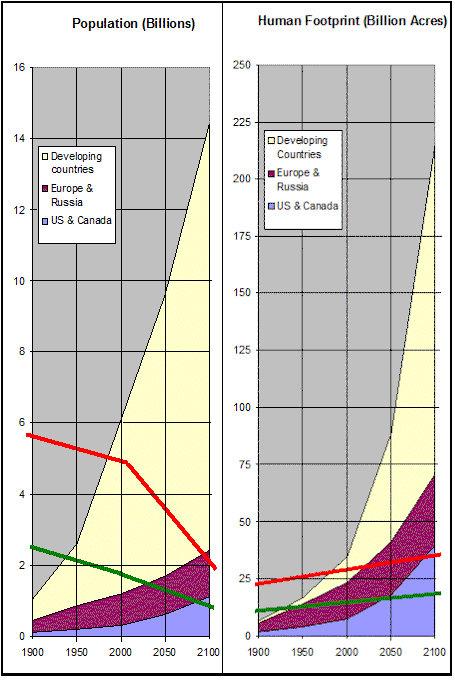Four years ago I reproduced a synopsis of two of the critical arguments from Daniel Quinn’s book Story of B, written by David Sheen, along with my own narrative. The first argument, The Boiling Frog, is that the population explosion depicted in the curve below is creeping up on us so slowly (and we have been lulled by dubious arguments that it will peak at ‘only’ 9-11 billion) that we won’t be able to cope with it until it overwhelms us. The second argument, Population: A Systems Approach, is that, contrary to conventional wisdom and intuition, the most humane and effective way to bring this explosion under control is to cut food production. (And yes, I know that a frog heated slowly in water is actually smart enough to jump out before it boils, but that doesn’t invalidate Quinn’s argument.) I think it’s worth re-reading, since four years later nothing has changed. Red lines indicate sustainable population and sustainable footprint at forecast levels of consumption and allowing for improvements in food technology, but with no provision for non-human species on the planet. Green lines include a provision for non-humans to inhabit half the world’s habitable area. Of all the radical ideas I have espoused in How to Save the World, none has proven to be as controversial as my belief that substantial human population reduction is a necessary condition (I am not sure whether it is a sufficient condition) to prevent ecological catastrophe in this century. The chart above, which I explained in this post, shows the impact of our continued population explosion, far beyond the levels of sustainability represented by the green and red lines on the chart (the green line allows for coexistence with other creatures, the red line hogs all resources on earth for humans). The chart below right shows the vicious cycle that Daniel Quinn argues, in The Story of B, has led us to this point. The argument is that (a) the exponential curve shown above is creeping up on us so quietly and quickly that if we wait for the first undeniable evidence of cataclysm, it will be too late, and (b) the root cause of the population explosion is excessive and ever-increasing food production, and the paradoxical and counter-intuitive solution to human misery caused by overpopulation and starvation is to cut food production. |
Navigation
Collapsniks
Albert Bates (US)
Andrew Nikiforuk (CA)
Brutus (US)
Carolyn Baker (US)*
Catherine Ingram (US)
Chris Hedges (US)
Dahr Jamail (US)
Dean Spillane-Walker (US)*
Derrick Jensen (US)
Dougald & Paul (IE/SE)*
Erik Michaels (US)
Gail Tverberg (US)
Guy McPherson (US)
Honest Sorcerer
Janaia & Robin (US)*
Jem Bendell (UK)
Mari Werner
Michael Dowd (US)*
Nate Hagens (US)
Paul Heft (US)*
Post Carbon Inst. (US)
Resilience (US)
Richard Heinberg (US)
Robert Jensen (US)
Roy Scranton (US)
Sam Mitchell (US)
Tim Morgan (UK)
Tim Watkins (UK)
Umair Haque (UK)
William Rees (CA)
XrayMike (AU)
Radical Non-Duality
Tony Parsons
Jim Newman
Tim Cliss
Andreas Müller
Kenneth Madden
Emerson Lim
Nancy Neithercut
Rosemarijn Roes
Frank McCaughey
Clare Cherikoff
Ere Parek, Izzy Cloke, Zabi AmaniEssential Reading
Archive by Category
My Bio, Contact Info, Signature Posts
About the Author (2023)
My Circles
E-mail me
--- My Best 200 Posts, 2003-22 by category, from newest to oldest ---
Collapse Watch:
Hope — On the Balance of Probabilities
The Caste War for the Dregs
Recuperation, Accommodation, Resilience
How Do We Teach the Critical Skills
Collapse Not Apocalypse
Effective Activism
'Making Sense of the World' Reading List
Notes From the Rising Dark
What is Exponential Decay
Collapse: Slowly Then Suddenly
Slouching Towards Bethlehem
Making Sense of Who We Are
What Would Net-Zero Emissions Look Like?
Post Collapse with Michael Dowd (video)
Why Economic Collapse Will Precede Climate Collapse
Being Adaptable: A Reminder List
A Culture of Fear
What Will It Take?
A Future Without Us
Dean Walker Interview (video)
The Mushroom at the End of the World
What Would It Take To Live Sustainably?
The New Political Map (Poster)
Beyond Belief
Complexity and Collapse
Requiem for a Species
Civilization Disease
What a Desolated Earth Looks Like
If We Had a Better Story...
Giving Up on Environmentalism
The Hard Part is Finding People Who Care
Going Vegan
The Dark & Gathering Sameness of the World
The End of Philosophy
A Short History of Progress
The Boiling Frog
Our Culture / Ourselves:
A CoVid-19 Recap
What It Means to be Human
A Culture Built on Wrong Models
Understanding Conservatives
Our Unique Capacity for Hatred
Not Meant to Govern Each Other
The Humanist Trap
Credulous
Amazing What People Get Used To
My Reluctant Misanthropy
The Dawn of Everything
Species Shame
Why Misinformation Doesn't Work
The Lab-Leak Hypothesis
The Right to Die
CoVid-19: Go for Zero
Pollard's Laws
On Caste
The Process of Self-Organization
The Tragic Spread of Misinformation
A Better Way to Work
The Needs of the Moment
Ask Yourself This
What to Believe Now?
Rogue Primate
Conversation & Silence
The Language of Our Eyes
True Story
May I Ask a Question?
Cultural Acedia: When We Can No Longer Care
Useless Advice
Several Short Sentences About Learning
Why I Don't Want to Hear Your Story
A Harvest of Myths
The Qualities of a Great Story
The Trouble With Stories
A Model of Identity & Community
Not Ready to Do What's Needed
A Culture of Dependence
So What's Next
Ten Things to Do When You're Feeling Hopeless
No Use to the World Broken
Living in Another World
Does Language Restrict What We Can Think?
The Value of Conversation Manifesto Nobody Knows Anything
If I Only Had 37 Days
The Only Life We Know
A Long Way Down
No Noble Savages
Figments of Reality
Too Far Ahead
Learning From Nature
The Rogue Animal
How the World Really Works:
Making Sense of Scents
An Age of Wonder
The Truth About Ukraine
Navigating Complexity
The Supply Chain Problem
The Promise of Dialogue
Too Dumb to Take Care of Ourselves
Extinction Capitalism
Homeless
Republicans Slide Into Fascism
All the Things I Was Wrong About
Several Short Sentences About Sharks
How Change Happens
What's the Best Possible Outcome?
The Perpetual Growth Machine
We Make Zero
How Long We've Been Around (graphic)
If You Wanted to Sabotage the Elections
Collective Intelligence & Complexity
Ten Things I Wish I'd Learned Earlier
The Problem With Systems
Against Hope (Video)
The Admission of Necessary Ignorance
Several Short Sentences About Jellyfish
Loren Eiseley, in Verse
A Synopsis of 'Finding the Sweet Spot'
Learning from Indigenous Cultures
The Gift Economy
The Job of the Media
The Wal-Mart Dilemma
The Illusion of the Separate Self, and Free Will:
No Free Will, No Freedom
The Other Side of 'No Me'
This Body Takes Me For a Walk
The Only One Who Really Knew Me
No Free Will — Fightin' Words
The Paradox of the Self
A Radical Non-Duality FAQ
What We Think We Know
Bark Bark Bark Bark Bark Bark Bark
Healing From Ourselves
The Entanglement Hypothesis
Nothing Needs to Happen
Nothing to Say About This
What I Wanted to Believe
A Continuous Reassemblage of Meaning
No Choice But to Misbehave
What's Apparently Happening
A Different Kind of Animal
Happy Now?
This Creature
Did Early Humans Have Selves?
Nothing On Offer Here
Even Simpler and More Hopeless Than That
Glimpses
How Our Bodies Sense the World
Fragments
What Happens in Vagus
We Have No Choice
Never Comfortable in the Skin of Self
Letting Go of the Story of Me
All There Is, Is This
A Theory of No Mind
Creative Works:
Mindful Wanderings (Reflections) (Archive)
A Prayer to No One
Frogs' Hollow (Short Story)
We Do What We Do (Poem)
Negative Assertions (Poem)
Reminder (Short Story)
A Canadian Sorry (Satire)
Under No Illusions (Short Story)
The Ever-Stranger (Poem)
The Fortune Teller (Short Story)
Non-Duality Dude (Play)
Your Self: An Owner's Manual (Satire)
All the Things I Thought I Knew (Short Story)
On the Shoulders of Giants (Short Story)
Improv (Poem)
Calling the Cage Freedom (Short Story)
Rune (Poem)
Only This (Poem)
The Other Extinction (Short Story)
Invisible (Poem)
Disruption (Short Story)
A Thought-Less Experiment (Poem)
Speaking Grosbeak (Short Story)
The Only Way There (Short Story)
The Wild Man (Short Story)
Flywheel (Short Story)
The Opposite of Presence (Satire)
How to Make Love Last (Poem)
The Horses' Bodies (Poem)
Enough (Lament)
Distracted (Short Story)
Worse, Still (Poem)
Conjurer (Satire)
A Conversation (Short Story)
Farewell to Albion (Poem)
My Other Sites




 I‘m preparing for a discussion forum on Friday in Quebec City, and one of the topics we’ll be discussing is how the “information behaviours” of Generation Millennium differ from those of previous generations, and what that means for the tools they (and the rest of us — they outnumber even the boomers) will and won’t be using in the future.
I‘m preparing for a discussion forum on Friday in Quebec City, and one of the topics we’ll be discussing is how the “information behaviours” of Generation Millennium differ from those of previous generations, and what that means for the tools they (and the rest of us — they outnumber even the boomers) will and won’t be using in the future.

 Much use is made of archetypes in the writing and criticism of literature, in art, and in psychology. Many of the gods of different religions are archetypal — intended as models to study or follow. The cards of the Tarot deck, especially the major arcana, are also archetypes, handy in the search for patterns of people and behaviours necessary to tell fortunes.
Much use is made of archetypes in the writing and criticism of literature, in art, and in psychology. Many of the gods of different religions are archetypal — intended as models to study or follow. The cards of the Tarot deck, especially the major arcana, are also archetypes, handy in the search for patterns of people and behaviours necessary to tell fortunes.

 The alternative media are abuzz with the news that Bruce Ivins, the USAMRIID research scientist at the US government lab at Fort Detrick who was in charge of work on anthrax vaccines, and who reportedly committed suicide Tuesday, was about to be charged with sending the 2001 anthrax-laced letters (including the one at right) and the resultant murder of five victims.
The alternative media are abuzz with the news that Bruce Ivins, the USAMRIID research scientist at the US government lab at Fort Detrick who was in charge of work on anthrax vaccines, and who reportedly committed suicide Tuesday, was about to be charged with sending the 2001 anthrax-laced letters (including the one at right) and the resultant murder of five victims.
 Patti Digh is recording the answers of readers to the question “What would you do today if you had just 37 days to live?” Some of these
Patti Digh is recording the answers of readers to the question “What would you do today if you had just 37 days to live?” Some of these 
 Kathy Sierra, on Twitter, challenged us to identify the good things that sometimes come out of bad circumstances. In complex systems — social and ecological systems particularly — the number of variables is infinite, so there are no discernible causes and effects, no consequences, no predictability, just trillions of things affecting each other. It’s inevitable that something intended to have positive effects will have, or appear to have, negative effects, sooner or later. And vice versa. Every technology invented has had unintended consequences, and every malicious invention has had some silver lining. Fireworks, gunpowder. Nuclear power, nuclear bombs. Smallpox vaccine, population explosion. Antibiotics, virulent drug-resistant strains. Butterfly wing flap, tsunami. Internal combustion engine, global warming.
Kathy Sierra, on Twitter, challenged us to identify the good things that sometimes come out of bad circumstances. In complex systems — social and ecological systems particularly — the number of variables is infinite, so there are no discernible causes and effects, no consequences, no predictability, just trillions of things affecting each other. It’s inevitable that something intended to have positive effects will have, or appear to have, negative effects, sooner or later. And vice versa. Every technology invented has had unintended consequences, and every malicious invention has had some silver lining. Fireworks, gunpowder. Nuclear power, nuclear bombs. Smallpox vaccine, population explosion. Antibiotics, virulent drug-resistant strains. Butterfly wing flap, tsunami. Internal combustion engine, global warming.





